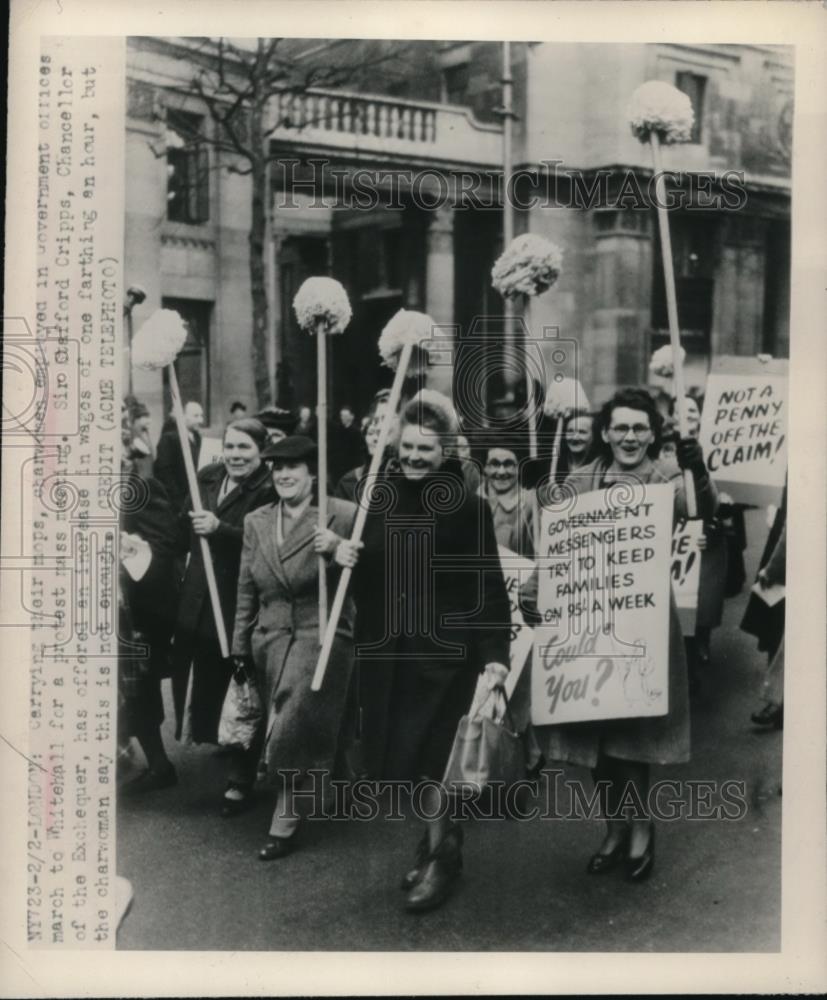Phillips
Final Exhibit- Phillips
Mops on the March, 1949 Protest Final Exhibit

Introduction/overview:
The Mops on the March protest of 1949 was a landmark demonstration in post-war London, led by working-class women demanding better living conditions, fair wages, and expanded social services. Taking place on February 1st, 1949 The march was a reaction to the severe housing shortages, severe economic misery, and sluggish social reform progress that plagued post-World War II Britain. The demonstration, which was named to represent the responsibilities that women bear at home, brought attention to the fact that they are not only strong change agents but also caregivers. During a trying time in British history, this grassroots movement continues to serve as a moving illustration of tenacity and teamwork.
Historiography:
Bose, From Marching With Mops To Burning Cash, Women Have Long Been Protesting For Equal Pay
Historiography Connections- Cultural History, Social History, Political History
Geographic Coverage- The Mops on the March, 1949 happened in London specifically from the Temple Gardens to Lincoln’s Inn Fields
Citation for this secondary source- Bose, Rakhi. “From Marching with Mops to Burning Cash, Women Have Long Been Protesting for Equal Pay.” Outlook India, 18 Jan. 2024, www.outlookindia.com/international/from-marching-with-mops-to-burning-cash-women-have-long-been-protesting-for-equal-pay-news-327544.
Press Release-
Rahki Bose is an Indian journalist and assistant editor at Outlook Publishing. Her work focuses on national news, politics, social issues, and human interest stories, particularly those based in Delhi. Bose writes about a wide array of topics, including gender issues, cultural movements, and government policies, often highlighting the challenges faced by marginalized communities. She is also recognized for her in-depth reporting on issues like mental health, gender-based violence, and religious conflicts.
Content- The content in this source expands on more than just the Mops on the March protest. It looks at significant protests all the way from 1911-2023. I obviously will focus on the Mops on March section, but for the press release I will mention some of the other events mentioned as well. For the Mops on the March section Bose mentions the number of cleaners which is one hundred, and why they were marching. They were marching due to the low wage they were receiving(34c), which could not keep up with inflation post war. They demanded a raise to 40c from Sir Stafford Cripps who was Chancellor of Exchequer. Bose also touches on the posters that were being held quoting one saying “Cleanliness is next to Godliness. Women cleaners are next to starvation”. Now, Bose also touches on other protests which I think is important because it shows the connection of the Mops on the March protest and other protest that followed which all fought for women equal pay. The first one that stood out was the Women’s strike for equality in 1970 which is described as US spearheaded by second-wave feminists like Betty Freidan brought over 50,000 women to New York City on August 26, that year being the 50th anniversary of the passing of the 19th Amendment which gave women voting rights. The protest had three self-stated goals in general: free abortion, equal opportunity in the workforce, and free childcare.[2] Another one touched on is the “Women’s Day Off” protest in 1990 when 90 per cent of women in the country walked out of their jobs to protest wage inequality and other gender disparities.[3]. The last protest I want to highlight is the “Day Without a Women” protest in 2017, Bose says it takes place in the US, inspired by International Women’s Day. Women are encouraged to strike from work and engage in other forms of protest to draw attention to gender inequality, including the wage gap.[3] I believe this is so important to show the ongoing fight for women’s rights around the world. The last key piece of information Bose touches on is the passing of the Equal Pay Act in 1963.[4]Although the act failed it is only 14 years following the Mops on the March protest, although it is in a different part of the world, I think it shows how impactful it was.
Impact on Historiography- I believe this had a very big impact on historiography because it really shows the connection of all of the protest fighting for the same goal. So, the history of women’s rallies for equal pay, ranging from the 1949 “Mops on the March” to more contemporary initiatives. By highlighting the persistence of gendered labor protests and the contribution of women to the fight against economic inequality, this source advances historiography. By showing how women’s efforts—often neglected in traditional labor studies—have played a crucial role in creating both economic and social history, it helps move the focus toward the nexus of gender, labor, and activism.
Analysis:
